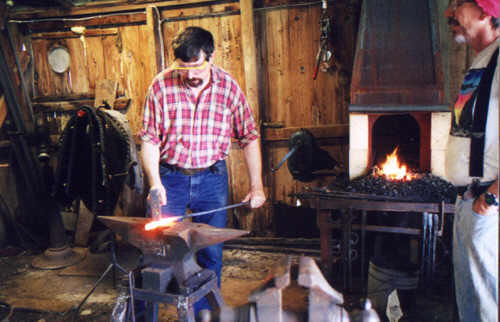
[Home] [ Back to Seminars & Classes Page ]
UPDATED September 19, 2019.

Hans Schlosser blacksmith
Possible new dates for this project.
These classes and teaching seminars are on hold again. Same problem as before - my work load is still too high and I cannot come up with enough time to conduct these seminars. With a little luck, I will have enough time to start these classes again next spring (2011). Updates will be posted here on this page.
For new smiths that interested in participating, please contact the webmaster at the email address at bottom of this page. These seminars are for beginners and novice level blacksmiths. Beginners do not need blacksmithing experience to participate in these seminars, and indeed it is preferred that new smiths have not had previous training or experience. This series of teaching events and seminars will be spread out over the fall and winter and spring - until Lilies War of 2011.
Get ready for the Capel Garmon firedog project
In preparation for the upcoming 2011 Lilies War, in the Kingdom of Calontir. Hands-on instructional workshops and teaching seminars will begin soon, to prepare a small group of new blacksmiths to forge a group project at the Lilies War 2011 - the Capel Garmon firedog. To create the Capel Garmon firedog, the smith must be able to forge weld heavy and light bars, forge animal heads, forge scrolls, punch, slit, rivet, and forge accurately to specified dimensions. The smith must also be able to make all of the tools that are required for this work because the special tooling can not be obtained anywhere else. The teaching seminars planned here will teach all of these skills. To learn more about the Capel Garmon firedog project go here: (new URL) http://www.beautifuliron.com/Lilies_War_Project_2011.htm . This events will be open only to SCA members.
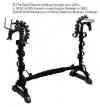 Firedog
project for Lilies War.
Firedog
project for Lilies War.PROJECT: To forge a replica of the Capel Garmon Firedog as a group project at the Lilies War.
For more information on the project go to my Lilies War Projects page by clicking the link here: (new URL) http://www.beautifuliron.com/Lilies_War_Project_2011.htm
This team project is for beginner level blacksmiths. Aspiring new blacksmiths who wish to participate in forging the Capel Garmon Firedog, must first become proficient in all tasks of the medieval blacksmith, and by proficient I mean that new smiths must be able to perform all forging tasks at the journeyman level. During this project, the new smith will learn advanced level blacksmithing skills through a series of classes and training workshops. These are live hands-on training seminars. Forging techniques will be taught in an I-do-you-do format. These new skills will then allow new smiths to make this complex firedog. All students will be required to do their best work. This is a requirement! You will do your very best work here or you will not be taught. This is a rare opportunity to learn the best techniques for only the cost of materials. These training seminars are only for new blacksmiths that really want to learn.
Class Schedule. To be announced (possibly starting around the end of October of 2010. Training seminars will be hosted in the shop of Hans Schlosser approximately one or two weekends each month until the next Lilies War. New SCA smiths that are interested in participating in this project and attending training should send email to Hans at the email address at bottom of this page.
Traditional blacksmithing skills. A series of teaching events will offer hands-on classes and workshops to teach beginning blacksmiths the traditional blacksmithing techniques that are used in the production of ornamental ironwork for residential and commercial customers. We will use traditional blacksmith methods to draw, taper, weld, punch, cut, bend, upset, shoulder, fuller, pierce, rivet, and twist. Using the coal forge, anvil, tongs, blacksmiths hammers, vises, punches and chisels and special tooling. No arc-welders, no gas welders, no grinders or sanders, no gas forges, no bondo. If a smith wants to see how to forge good tools and good ironwork then this is the place to see it - and learn it.
Teaching projects will include: small tools and punches, hammers and hammer tools, tongs (light and heavy), carving animal faces and animal heads, scrollwork and forging scroll jigs, building forges and bellows including the pair-of (side by side) bellows and the great (compound) bellows. These are real projects. We will actually be making these things during the forging/teaching seminars. Students will take their finished projects home with them. Many of these same tools, forges, and bellows, will be used during the Lilies War event. At least 3 sets of forges and bellows must be made before the Lilies War event, so that we have enough forging stations for each forging team.
The blacksmith shop is undergoing renovation at this time. The building is approximately 21-feet square with an 8-foot ceiling. There will be two forge hearths set up in this shop after renovation is complete. However, there will be only one anvil available. We will need more anvils. Scroll further down the page to see the most recent photos of the blacksmith shop.
Class size is limited. To be announced. Due to limited number of forges and space, classes will be limited to 4 students, or possibly as many as 6 or 7 blacksmith students at one time (2 per fire and 2 or more students for forge and bellows construction).
Safety considerations. Eye protection is required for all smithing classes. We will provide safety glasses for those students who don't have their own. Gloves are not needed and will interfere with much of the blacksmith's work. Anyone using gloves will be allowed to use only loosely fitting welders gloves. Blacksmithing is dirty and dangerous work. You will get burned! That is the nature of this business.
Costs. I have not determined costs of materials at this time. Some could become very expensive - such as materials to build the bellows. We can save on cost of lumber for the bellows and forges, by purchasing our lumber at a nearby sawmill. But I don't have a good source for the leather. Steel is expensive. Fortunately, we don't need to buy a lot of steel for this project. Coal is going to get much more expensive. I have not purchased coal in a long time, so I am guessing that the cost of a fire will be around $2 per hour. I will have a better idea on costs after some investigation later.

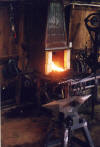
 August
26, 2008. These photos reflect the most recent equipment arrangement in the
shop. New photos will be added soon. Older photos of the shop are at the bottom of
this page.
August
26, 2008. These photos reflect the most recent equipment arrangement in the
shop. New photos will be added soon. Older photos of the shop are at the bottom of
this page.
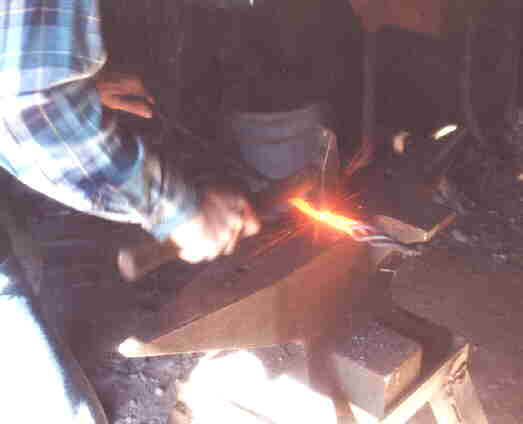 Page
updated Thursday, September 19, 2019.
This page will be rewritten and updated when new classes are scheduled soon.
Page
updated Thursday, September 19, 2019.
This page will be rewritten and updated when new classes are scheduled soon.
1) Basic blacksmithing and fire tool making. Class length is 1 and a half days.
Beginning on Friday night. Setup is Friday night so we can make sure all the forges brought to the seminar, are working. A short demonstration of basic techniques and some blacksmithing related tapes are planned for the evening. A forge welding demonstration will be held Friday evening and the item to be welded is a basket cage handle for fire tools, for those smiths ready to advance their skills. See what the basket cage is used for lower on this page. It is not necessary to be present for this evening session.
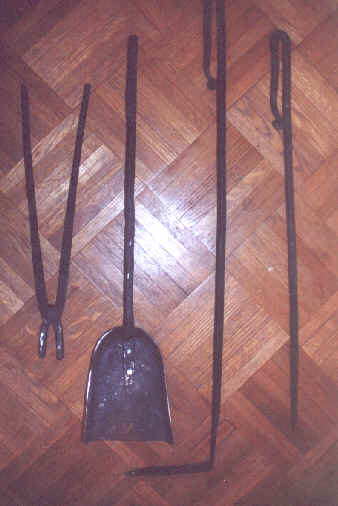 Hands-on training begins
Saturday. The project for this class is the making of fire-tending tools for new
smiths while learning professional fire tending techniques. Bending, punching, drawing,
tapering, twisting, riveting willing will be taught in the process of making the tools the
smith will need for his/her own forge work at home. The fire tools to be made during the
class will have simple scrolled handles like the ones in the photo at left. The tools made
in photo at left were made by one of the students during the latest class and are
light-weight and strong enough for years of use. Participants keep the fire tools.
Hands-on training begins
Saturday. The project for this class is the making of fire-tending tools for new
smiths while learning professional fire tending techniques. Bending, punching, drawing,
tapering, twisting, riveting willing will be taught in the process of making the tools the
smith will need for his/her own forge work at home. The fire tools to be made during the
class will have simple scrolled handles like the ones in the photo at left. The tools made
in photo at left were made by one of the students during the latest class and are
light-weight and strong enough for years of use. Participants keep the fire tools.
And again, focus will be on professional fire tending techniques. No hollow fires or 'igloo' fires are taught here. We will use a much simpler and hotter type of fire which is also ideal for fire-welding.
What to bring. Students need to bring hammers if they have them. However there are two complete forging stations with tools at this shop so there will be tools for a couple of smiths. What kinds of hammers? Cross peens types are the best for this class, in the 2 lb. to 3.5 lb. range. Need both if you have them. Ball peens will work also. Claw hammers should be avoided. We have all the tongs needed as well as other supplies. Participants must bring their own safety glasses, goggles or face shields. Gloves are not needed and will actually cause problems in this class.
Cost of this class is $30.00. Due to the high price of smithing materials and supplies when we run this class again the cost of the class may be higher.
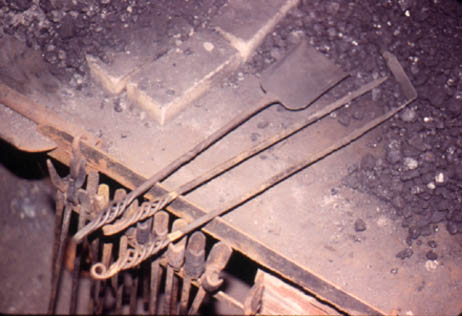 At
right is a photo of the author's fire tools with welded basket cage style
handles. In this class it is the scrolled handled style fire tools that we will
make. While the basket cage handles are demonstrated at the beginning of the
class, it is only to show how it is done. Fire welding is too complex to be
effectively taught in this class. The basket handles are more comfortable to use
and many smiths eventually make this style when their skills improve enough to
allow them to do so. Again we will be making the scrolled style handles in this
class as seen in the photo above left.
At
right is a photo of the author's fire tools with welded basket cage style
handles. In this class it is the scrolled handled style fire tools that we will
make. While the basket cage handles are demonstrated at the beginning of the
class, it is only to show how it is done. Fire welding is too complex to be
effectively taught in this class. The basket handles are more comfortable to use
and many smiths eventually make this style when their skills improve enough to
allow them to do so. Again we will be making the scrolled style handles in this
class as seen in the photo above left.
For class dates and location see Blacksmith Class Announcement page at http://www.beautifuliron.com/class.htm
Updated Thursday, September 19, 2019.
Under construction. June 11th, 2001.